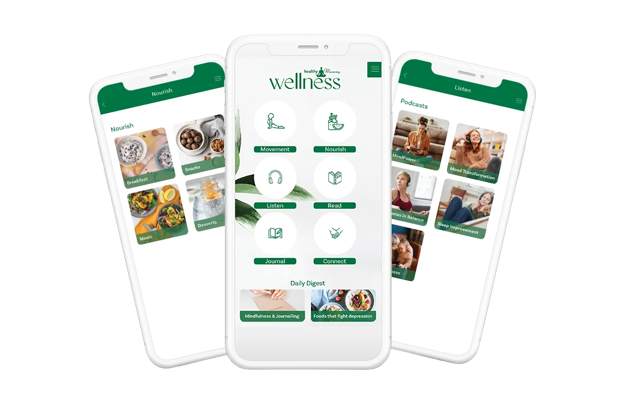![]()
Anxiety: Emotional Brain vs The Smart Brain

After speaking to thousands of women about what exactly keeps them up at night, we’ve identified some core health concerns that are extremely common amongst our community. We discovered that feeling anxious was a common feeling amongst us.
Anxiety is excessive, uncontrollable, and often irrational anticipation of future threats. Anxiety is one of the most commonly diagnosed mental health conditions in Australia.
We want to know what’s involved, how it works, how knowing it is going to empower us and what we can do to help. Our research tells us that we have a choice and we can in fact retrain our brain.
This article has really useful tools in helping combat negative thoughts…

Breaking anxiety down
Understanding how anxiety works is really important and is a golden tool within itself because, if we know how a system works, we can in turn work the system.
Lynn Jenkins is a clinical psychologist and her passion is early intervention and as such, works mostly with parents and children. She has written several books for children on topics such as anxiety, perfectionism, perception, grief and mindfulness.
She explains what is involved with anxiety from the perspective of the body, because that’s where we feel it and that’s where we are experiencing it.
Three areas of anxiey
Anxiety can be broken down into 3 specific areas – the brain, the nervous system and how we are wired as humans with this concept called negatively bias.
If you have seen the children’s film The Croods, Mr Crood is a good example of negativity bias. For those who haven’t seen the film it’s set in the caveman days and Mr Crood is responsible for his family, he wants to keep them all safe by keeping them in the cave.
It’s all about survival. And that’s exactly what negativity bias is. Mr Crood tells stories of danger and that’s how we are wired as humans and this is a survival wiring.
“As humans we are animals and at the end of the day survival is still paramount” Lynn explains.
3 sections of the brain
The bottom part of the brain is the basic brain responsible for everything we do automatically. Breathing, blood flow, digestion, and heartbeat.
In the middle, we have our emotion brain.
Then behind our forehead over the top we have our smart brain and that’s what differentiates us from other animals. The smart brain makes us human, and provides all the abilities that make us clever. This means we can think complexly, we can problem solve, plan, and make good choices.
When it comes to anxiety, there is a part of the emotion brain called the amygdala, which is like the starting point. And we love Lynn’s explanation of this.
“So, if you can imagine a structure there with a little hand over a safe button and an unsafe button and that’s all his choices are. Whether we depress the safe button or the unsafe button. If he presses the safe button he puts us in the calm part of our nervous system,” she says.
“If he presses the unsafe button then its job is to turn on our protection system and that’s what we feel when we’re anxious. So our body has two ways of protecting us – withdrawing and shutting down or fight or flight. That’s how our body is wired to protect us. Again very primitive…”

Fight or flight
When it comes to anxiety and stress, and even anger, it’s the fight flight part of our nervous system that we’re occupying. When we feel that anxiety that’s our body protecting ourselves. This feels very physical and it is as our body quite literally feels it’s helping us defend against something life threatening.
To explain fight or flight, it is all our blood shooting very rapidly, increased by 200%, to our arms and our legs or our big muscles to be specific. Our run or fight limbs. We shut off other systems like our digestion system, as our body can’t afford to protect us really well and digest food at the same time so it knows to temporarily shut down other symptoms because survival takes priority.
You may all be familiar with having to nervous frequent trips to the toilet when we’re anxious and this is because of our survival system, not because of tummy issues! If we have to run or fight we have to be as light as possible and if there’s anything in there that could slow us down it is evacuated.
To get the blood out quickly our heart is working overtime and our heart rate increases. When we are anxious our protection system is extremely physical and it is important to recognise and understand this as we can often mistake these symptoms for something else.
How to manage anxiety

The part we need to focus on when it comes to anxiety and managing anxiety is that the amygdala makes the decision whether to press the safe button or the unsafe button, based on the input it receives.
The input it receives comes from the way we think. And this is anxiety. Anxiety is like scary stories or creative catastrophes that often start with “what if that” and “what if this” and that is where the negative bias comes in.
Anxiety is usually in the future, and hasn’t eventuated yet and when it comes to uncertainty and the unknown our brain and the way we’re wired, our thoughts go straight to the negative. If we let it be, that’s how it would be.
This negative thinking associated with anxiety can manifest in many ways but an example may be starting in new workplace and you won’t know anyone. You may feel nervous and start thinking you may not be good enough and get found out, and this then represents a threat to your body. Your amygdala is always listening!
If our body interprets a threat, it will press the unsafe button, turn on your protection system and you will start to feel anxious.
Emotional Brain vs Smart Brain
“When it comes to managing anxiety, I think it’s really important to understand this, because we have to remember that we’ve got a smart brain with the ability to override the emotion brain,” says Lynn.
“But we’re not really taught that or practiced at that, because the feeling of fear and anxiety tends to lead, which makes sense when we remember we’re animals and it’s all about survival. But it’s like we have a smart brain and don’t use it in these circumstances necessarily, unless we are taught and unless we practice.”
And the good news is that we can teach ourselves to rewire. Awareness is the place where we must start. Knowing we can all be like Mr Crood empowers us.
How to limit negative thoughts
Negative thoughts are like Velcro – they stick to our brain and we’re wired for positive thoughts be like Teflon, and just slide off our brain and not stick. Lynn explains that research now is telling us to “take in the good,” and to put simply this means that knowing this about our brain empowers us.
When we are thinking negative thoughts we know these thoughts are going to be sticking to our brain like Velcro and if we let them be, research tells us the biology takes over, the amygdala thinks that’s unsafe and the protection system makes us anxious.
If we know this and can choose not to rely on the biology or the brain to do the work itself we can consciously choose what messages reach the brain. The research supported concept of “taking in the good” means that we need to hold onto that good positive thought and feel it for 10 to 20 seconds and then it registers on the brain, and stops slipping off like Teflon. And this is rewiring the brain for happiness.
When you know how it works you can in turn work it. In the busy world we now live in we often don’t appreciate these things in the moment or take the time for things to register and this is where our awareness and practice has to take over.
Get access to Anxiety Wellness Programs in the Wellness App

The Healthy Mummy Wellness app is built to support mums’ mental, physical and social wellbeing. We have expert advice to help mums makeover their minds, transform their mood, manage their hormones, sleep better and engage with their family. You can listen to podcasts, read blogs, work out with our trainers and find healthy, family-friendly recipes from the palm of your hand.


